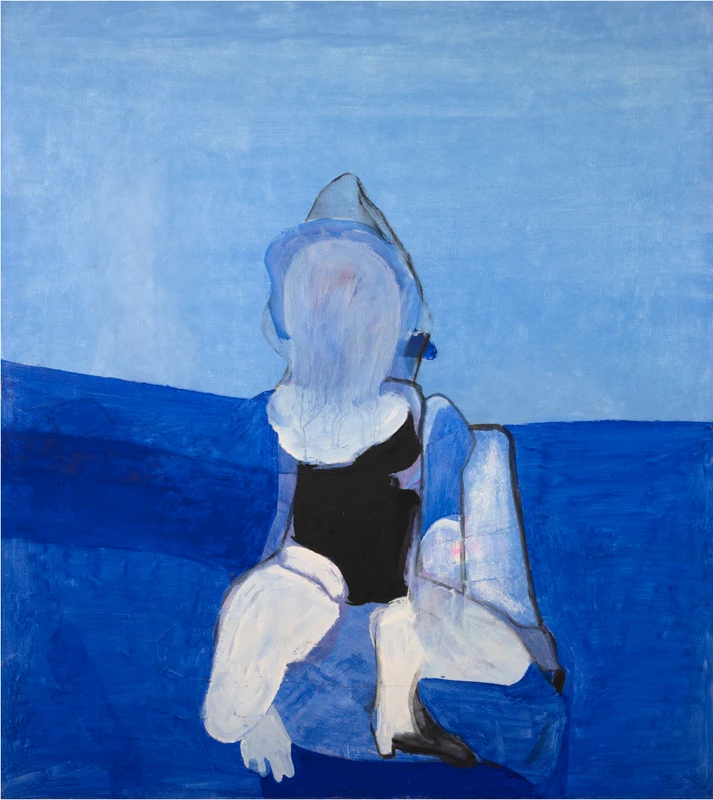Teresa Pągowska: Shadow Self
14 Feb-2 Apr 2025


Thaddaeus Ropac London is pleased to present Shadow Self, the first UK solo exhibition of painter Teresa Pągowska (b. Warsaw, 1926–2007), spanning five decades of her practice. A key figure in postwar Polish art, Pągowska is recognised for her sensitive depictions of the female figure and her innovative use of pure canvas as a pictorial element of her paintings. While not completely abstract, Pągowska’s figures – often shown dissolving or metamorphosing in space – mark a transition from the machine-like modernist body that prevailed before the Second World War towards an intimately felt, emancipated representation. Through the recurring motif of the shadow, the exhibition will trace the development of Pągowska’s practice from the early 1960s to the mid-2000s, featuring paintings from her major series, alongside a selection of works on paper.
Teresa Pągowska’s acute sense of colour was initially influenced by the Colourists (Kapists), a group of Polish painters active in Paris in the 1920s and 1930s, who were inspired by Henri Matisse, Paul Cézanne and Pierre Bonnard. In 1955, she participated in the landmark All-Poland Exhibition of Young Art. Against the war—against fascism held at Warsaw’s Arsenal, which marked an important shift from the restrictive aesthetic principles of Socialist Realism. During the 1960s, Pągowska experimented with the abstract, improvisational tendencies of Art Informel, as well as the expressive pictorial language later associated with the New Figuration movement to develop her signature style and an expanded approach to the human form. In 1961, she was one of only two women artists selected for the exhibition Fifteen Polish Painters at the Museum of Modern Art in New York. Peter Selz, the curator of this historic show, identified a distinctly personal and experiential quality in Pągowska’s painting: ‘Her abstractions seem to find their origins in the experience of nature, not as it is observed from a distance with a horizon, but experienced intimately.’
More recently, the art historian and MoMA PS1 director Cornelia Butler has credited Pągowska with being one of the first Polish artists to consciously address and unravel conventional representations of women in their art. Like her contemporaries Alina Szapocznikow and Magdalena Abakanowicz, ‘Pągowska [was] also working prior to a feminist language or discourse, but clearly interrogating how the integrity of the modernist body might be undone.’ Pągowska’s fragmented, semi-abstract bodies also allude to the unrepresentable experience of trauma in postwar Europe. They become the fertile ground for rediscovery and transformation, while remaining independent from objectification and prescribed social roles. ‘What occupies me most profoundly is the human figure,’ the artist said. ‘Not only because of the richness of form. I think that it is the human body that contains the most content-related magic.’
The motif of the shadow is a thread in the exhibition. In Pągowska’s pictorial universe, it functions as both a formal and metaphorical device, evoking notions of duality while reflecting the artist’s underlying fascination with mystery. Shadows exist at the boundary between the body and its environment and, by exploring their shifting, intangible outlines with paint, Pągowska juxtaposes light and dark, form and absence. In Bath (1974), a nude female figure is accompanied by a pale grey shadow that looms above her like an independent presence of its own. At once liberated and menacing, it seems to embody and enact the secret or fantasised parts of the self: one’s unconscious fears, desires or impulses.
Shadow Self at Thaddaeus Ropac presents important examples of Pągowska’s late-1960s and early-1970s practice in which figures inhabit enclosed domestic spaces or seashores inspired by the coasts of northern Poland, rendered with rich, gestural passages of paint. Interior (1970) is part of a group of paintings that features one-point perspectives. These works set a dramatic and enigmatic atmosphere: some resemble crime scenes with bodies on the ground while others are dreamlike, containing rippling curtains, passing shadows and multiple open doors. As Pągowska reflected, ‘each painting depicts an experience and materialises a dream.’
By the mid-1970s, Pągowska reduced the chromatic intensity of her paintings and began to experiment with the interplay of positive and negative space. She integrated large areas of raw, exposed canvas into her paintings, radically inverting the traditional hierarchy between the painted subject and the painterly ground. In Monochrome XXXXC (1975), a significant work from the artist’s Monochromes series, the female figure is represented through bare, unpainted space, while the background is painted. Using the actual material of the canvas as a pictorial element became a characteristic trait of her practice. It allowed her to play with variations of textures, economise her means of expression and open up space for the imagination, fulfilling what the artist described as a ‘yearning to express “everything” with “nothing”’. Throughout the following years, Pągowska’s paintings become populated with enigmatic animal presences, and in the 1990s and 2000s, she began to fuse animal and human forms.
The exhibition also features a selection of works on paper – gouaches, inks, charcoals and collages – that offer insight into Pągowska’s artistic process, while also demonstrating her interest in hybrid, interspecies forms. She often repurposed found, everyday materials including magazines and creased wrapping papers, drawn to their irregular textures and tactile surfaces. ‘I have a taste for errors and mistakes, which when skillfully accumulated, may acquire their special power,’ she said, ‘they give the picture its character.’ The collages on view incorporate the stencils that the artist often used to create her paintings. Like other artists of her generation – particularly Pop artists such as Roy Lichtenstein, Andy Warhol and Tom Wesselmann, whom she admired – Pągowska borrowed techniques from commercial printing, redefining its language for her own abstract and expressive vision.